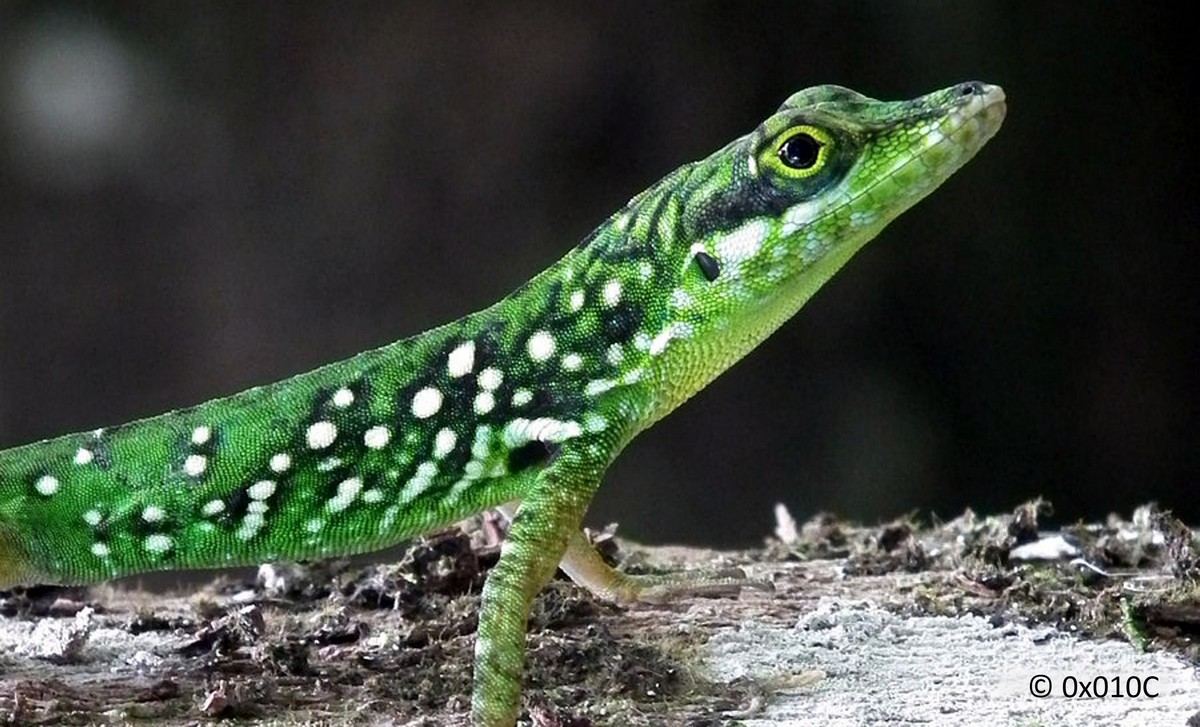
- Scientific name : Anolis roquet (Bonnaterre, 1789)
- Local name : Martinique anole, Martinique’s anole, Savannah anole.
- Order : Dactyloidae
- Family : Squamata
Description
Morphologie. Anole de taille moyenne au museau long et spatulé. La couleur du dos varie du vert au marron, en incluant toutes les variations entre ces teintes. Certains individus arborent également des teintes bleutées et grises. Le dos est également parcouru de points clairs superposés à des marques et taches plus sombres. La face ventrale est généralement plus claire, avec des rayures latérales également claires. Le fanon gulaire est généralement jaune vif.
Taille corporelle standard (longueur tête-tronc). mâles: 74 à 140 mm; femelles: 55 à 86 mm (Nicholson et al., 2012).
Dimorphisme sexuel. Seuls les mâles présentent un fanon gulaire.
Variations. La couleur du corps et les motifs associés varient fortement entre les différentes populations sur l’aire de répartition d’origine de l’espèce (Thorpe et al., 2008; 2010).
La teinte du corps d’un même individu peut également varier, du clair au sombre, selon son état.
Confusion possible avec d’autres espèces. La confusion est possible avec une espèce proche au plan phylogénétique, Anolis extremus, originaire de la Barbade.
Distribution
Native. Martinique.
Introduit. Un individu récemment capturé à la Dominique (Sulton, 2020). Cependant, à ce jour, aucune population établie n’a été identifiée sur l’île.
Biologie et écologie
Habitat. Anolis roquet évolue dans une grande diversité d’habitats naturels, des environnements littoraux xériques aux forêts humides d’altitude (Thorpe et al., 2010; 2015).
Régime alimentaire. Insectivore et frugivore (Bille, 2018).
Reproduction. La femelle dépose un unique œuf à intervalle d’une à deux semaines. La reproduction a lieu tout au long de l’année si les conditions le permettent (Clobert et al., 1998).
Comportement. Comme chez la plupart des anoles, les mâles peuvent déployer leur fanon gulaire afin de défendre leur territoire, ou lorsqu’ils sont à la recherche d’une partenaire pour la reproduction.
Impact et gestion des populations introduites
Impact. Aucune étude d’impact n’a été menée.
Gestion. Aucune mesure de contrôle ciblée n’est à ce jour établie.
Bibliographie
- Ackley, J. W., Muelleman, P. J., Carter, R. E., Henderson, R. W., & Powell, R. (2009). A rapid assessment of herpetofaunal diversity in variously altered habitats on Dominica. Applied Herpetology, 6, 171–184.
- Auguste, R. J., Dass, K., & Baldeo, D. (2018). Discovery of the Puerto Rican Crested Anole, Anolis cristatellus Duméril & Bibron, on Trinidad. Caribbean Herpetology, 63, 1–2.
- Breuil, M., Guiougou, F., Questel, K., & Ibéné, B. (2009). Modifications du peuplement herpétologique dans les Antilles françaises : disparitions et espèces allochtones. 2ème partie : Reptiles. Le Courrier de La Nature, 251, 36–43.
- Campbell, N., Thawley, C. J., & Stroud, J. T. (2018). Anolis cristatellus (Puerto Rican Crested Anole). Cannibalism. Herpetological Review, 49, 115–116.
- Chejanovski, Z. A., Avilés-Rodríguez, K. J., Lapiedra, O., Preisser, E. L., & Kolbe, J. J. (2017). An experimental evaluation of foraging decisions in urban and natural forest populations of Anolis lizards. Urban Ecosystems, 20, 1011–1018.
- Drakeley, M., Lapiedra, O., & Kolbe, J. J. (2015). Predation risk perception, food density and conspecific cues shape foraging decisions in a tropical lizard. PLoS ONE, 10, 1–16.
- Dufour, C. M. S., Clark, D. L., Herrel, A., & Losos, J. B. (2020). Recent biological invasion shapes species recognition and aggressive behaviour in a native species: a behavioural experiment using robots in the field. Journal of Animal Ecology, 89, 1604–1614.
- Dufour, C. M. S., Herrel, A., & Losos, J. B. (2018). Ecological character displacement between a native and an introduced species: the invasion of Anolis cristatellus in Dominica. Biological Journal of the Linnean Society, 123, 43–54.
- Eales, J., Thorpe, R. S., & Malhotra, A. (2008). Weak founder effect signal in a recent introduction of Caribbean Anolis. Molecular Ecology, 17, 1416–1426.
- Eales, J., Thorpe, R. S., & Malhotra, A. (2010). Colonization history and genetic diversity: adaptive potential in early stage invasions. Molecular Ecology, 19, 2858–2869.
- Fitch, H. S., Henderson, R. W., & Guarisco, H. (1989). Aspects of the ecology of an introduced anole: Anolis cristatellus in the Dominican Republic. Amphibia Reptilia, 10, 307–320.
- Gorman, G C Licht, P. (1974). Seasonality in ovarian cycles among tropical anolis lizards. Ecological Society of America, 55, 360–369.
- Hahn, M., & Köhler, G. (2010). Morphological variation in Anolis cristatellus. Salamandra, 46, 117–120.
- Hall, J. M., & Warner, D. A. (2017). Body size and reproduction of a non-native lizard are enhanced in an urban environment. Biological Journal of the Linnean Society, 122, 860–871.
- Kelehear, C., & Graham, S. P. (2015). Anolis cristatellus (Crested Anole). Diet. Herpetological Review, 46, 431.
- Kolbe, J. J., Glor, R. E., Schettino, L. R., Lara, A. C., Larson, A., & Losos, J. B. (2007). Multiple sources, admixture, and genetic variation in introduced Anolis lizard populations. Conservation Biology, 21, 1612–1625.
- Kolbe, J. J., VanMiddlesworth, P. S., Losin, N., Dappen, N., & Losos, J. B. (2012). Climatic niche shift predicts thermal trait response in one but not both introductions of the Puerto Rican lizard Anolis cristatellus to Miami, Florida, USA. Ecology and Evolution, 2, 1503–1516.
- Krysko, K. L., Enge, K. M., Donlan, E. M., Golden, E. A., Burgess, J. P., & Larson, K. W. (2009). The non-marine herpetofauna of Key Biscayne, Florida. Herpetological Conservation and Biology, 5, 132–142.
- Lawson, G. R., Norden, A. W., & Rothermel, B. B. (2019). Geographic distribution. Anolis cristatellus (Crested Anole). USA: Florida. Herpetological Review, 50, 524.
- Leal, M., & Fleishman, L. J. (2004). Differences in visual signal design and detectability between allopatric populations of Anolis lizards. American Naturalist, 163, 26–39.
- Leal, M., & Gunderson, A. R. (2012). Rapid change in the thermal tolerance of a tropical lizard. American Naturalist, 180, 815–822.
- Leal, M., & Rodriguez-Robles, J. A. (1997). Signalling displays during predator-prey interactions in a Puerto Rican anole, Anolis cristatellus. Animal Behaviour, 54, 1147–1154.
- Losos JB, 2009. Lizards in an evolutionary tree. Berkeley, California, USA: University of California Press, 512
- Malhotra, A., Thorpe, R. S., Hypolite, E., & James, A. (2007). A report on the status of the herpetofauna of the commonwealth of Dominica, West Indies. Applied Herpetology, 4, 177–194.
- Nicholson, K. E., Crother, B. I., Guyer, C., & Savage, J. a Y. M. (2012). It is time for a new classification of anoles (Squamata: Dactyloidae). Zootaxa, 3477, 1–108.
- Nicholson, K. E., Crother, B. I., Guyer, C., & Savage, J. M. (2018). Translating a clade based classification into one that is valid under the international code of zoological nomenclature: the case of the lizards of the family Dactyloidae (Order Squamata). Zootaxa, 4461, 573–586.
- Otero, L. M., Huey, R. B., & Gorman, G. C. (2015). A few meters matter: Local habitats drive reproductive cycles in a tropical lizard. American Naturalist, 186, E72–E80.
- Poe, S., Nieto-Montes De Oca, A., Torres-Carvajal, O., De Queiroz, K., Velasco, J. A., Truett, B., … Ian Latella, A. (2017). A phylogenetic, biogeographic, and taxonomic study of all extant species of anolis (Squamata; Iguanidae). Systematic Biology, 66, 663–697.
- Powell R., Henderson R. W., Parmerlee Jr. J. S. (2015). The reptiles and amphibians of the Dutch Caribbean: Saba, St. Eustatius, and St. Maarten. Bonaire, Dutch Caribbean: Dutch Caribbean Nature Alliance, 343
- Prado-Irwin, S. R., Revell, L. J., & Winchell, K. M. (2019). Variation in tail morphology across urban and forest populations of the crested anole (Anolis cristatellus). Biological Journal of the Linnean Society, 128, 632–644.
- Thawley, C. J., Moniz, H. A., Merritt, A. J., Battles, A. C., Michaelides, S. N., & Kolbe, J. J. (2019). Urbanization affects body size and parasitism but not thermal preferences in Anolis lizards. Journal of Urban Ecology, 5, 1–9.
- Winchell, K. M., Reynolds, R. G., Prado-Irwin, S. R., Puente-Rolón, A. R., & Revell, L. J. (2016). Phenotypic shifts in urban areas in the tropical lizard Anolis cristatellus. Evolution, 70, 1009–1022.
- Yokoyama, M. (2012). Reptiles and Amphibians introduced on St. Martin, Lesser Antilles. Reptiles & Amphibians, 19, 271–279.





